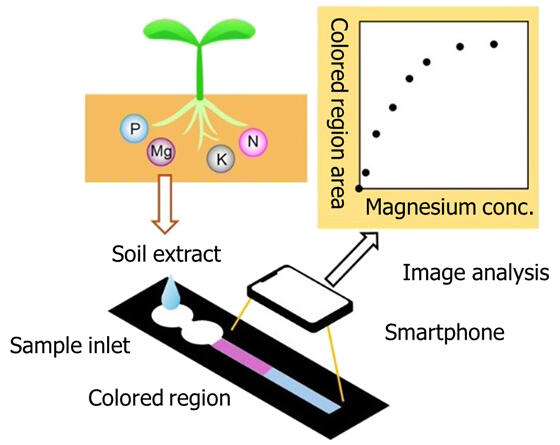The research group of Graduate Student Nozomi Nagase at the Graduate School of Chemical Sciences and Engineering together with Assistant Professor Akihiko Ishida, Assistant Professor Mitsue Hibino, Associate Professor Masatoshi Maeki, and Professor Manabu Tokeshi at the Graduate School of Engineering at Hokkaido University announced that they developed a paper-based analysis device that can measure the magnesium ion (Mg2+) concentration in soil in 3 min. Mg2+ concentrations can be measured using the image analysis of a business card-sized piece of filter paper incorporating flow channels and reagents for automated analytical reactions with a single drop of solution. The researchers are already developing a smartphone application that can analyze images and features to quantify items other than magnesium, with the aim of developing a low-cost and easy-to-use device that enables one in the field to determine the correct fertilizer amount to be used there. This result is expected to help solve agricultural problems such as environmental pollution and soil degradation caused by excessive fertilizer use. The results were presented at the 73rd Annual Meeting of the Japan Society for Analytical Chemistry held at the Nagoya Institute of Technology (Nagoya, Japan) from September 11-13.

Provided by Hokkaio University
Excessive fertilization leads to environmental pollution and soil degradation due to runoff, which poses a challenge for sustainable agriculture. Additionally, soil analysis and diagnosis must be conducted by a specialized organization, and such analyses are expensive and time-consuming, taking approximately one month to obtain results. In general soil analyses, soils from multiple locations in a field are mixed, making it difficult to determine the correct fertilizer amount to be used.
To date, the research group has focused on developing various analytical techniques with the support of the Hokkaido University's Robust Agriculture, Forestry and Fisheries Research and Development Platform. Since last year, the group has been working on the development of a simple and low-cost soil diagnostic device, which was selected for the FY2023 Research and implementation promotion program through open innovation of the Bio-oriented Technology Research Advancement Institution.
The newly developed device contains a microchannel, with reagents being incorporated into a filter paper. The analytical procedure is performed automatically when a sample liquid (a solution of sample soil dissolved in an extractant) is dropped onto the inlet of the flow channel and flowed due to the capillary action. Areas other than the flow channel are solidified with a water-repellent ink; therefore, the capillary action occurs only in the channel. A colored region whose area increases with the Mg2+ concentration is located downstream of the flow channel, and the Mg2+ concentration can be measured through the image analysis of this area.
Currently, the research group is working with a company to develop a smartphone application for image analysis that will enable farmers in the field to determine the correct fertilizer amount to be applied there as well as devices that can measure nitrate, phosphorus and potassium concentrations and pH. Ultimately, they plan to develop a device that can analyze five substances, including Mg2+, using a single piece of paper.
The three steps to use the developed device are as follows: add soil to the extractant, stir, and add a drop of the supernatant onto the device. The devices are disposable and are expected to cost approximately 300 yen each. The application to be developed will have a function to suggest the necessary fertilizer amount and will enable farmers in the field to determine the fertilizer amount to be used there easily and inexpensively.
Demonstration tests will begin as early as this fiscal year at the Central Agricultural Experiment Station of the Hokkaido Research Organization and demonstration farm of the Hokuren Federation of Agricultural Cooperatives. The researchers are considering developing devices not only for estimating nutritional components but also for determining harmful components.
Ishida said, "Because soil contents are not uniform, it is necessary to perform measurements from multiple locations in one field. We have designed the system to be simple, quick, and inexpensive so that it is not burdensome to analyze data from multiple locations each time analysis is needed. In the past, a fixed fertilizer amount was used uniformly; however, it is now revealed that this approach causes excessive fertilization. By understanding the fertilizer distribution to some extent and applying fertilizers properly, we hope to eliminate the tendency for excessive fertilization and contribute to solving agricultural problems."
This article has been translated by JST with permission from The Science News Ltd. (https://sci-news.co.jp/). Unauthorized reproduction of the article and photographs is prohibited.




